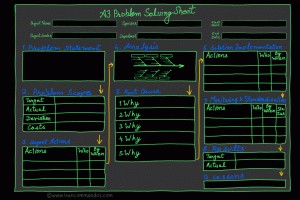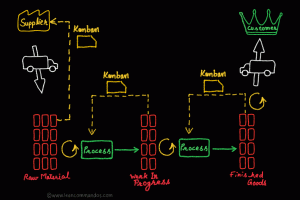Introduction
Jidoka, a cornerstone principle in Lean manufacturing, represents a significant shift in the production process by integrating human intelligence with the mechanical process. Coined from Japanese origins, Jidoka, or ‘Autonomation’, denotes ‘automation with a human touch’. It’s a strategy aimed at enhancing quality and efficiency by halting production when a defect is detected. Thus, allowing immediate attention to problems, preventing defects from progressing down the line
History and Development
Originating from the Toyota Production System, Jidoka was developed when Sakichi Toyoda invented a textile loom that stopped automatically when a thread broke. This early example of Jidoka provided the groundwork for integrating quality control within the production process. Over time, Jidoka evolved into a broader concept beyond machinery, representing a critical quality assurance method in Lean management
Key Principles
The fundamental principle of Jidoka is to stop production to fix problems to get quality right the first time. The key principles include detecting an abnormality, stopping production, fixing the immediate problem, and investigating and solving the root cause of the issue. This proactive approach ensures that defects do not move to the next stage of production.

When to Use the Tool
Jidoka is particularly useful in repetitive production processes where speed and consistency are crucial. It’s best applied when quality issues arise, and there’s a need to eliminate waste, reduce costs, and ensure product quality. Its use is also vital in operations looking to empower workers to be part of the problem-solving process.
How It Works
Implementing Jidoka involves a structured approach aimed at embedding quality assurance within the production process. It operates through several interconnected steps that synergize human intelligence with technological advancements:
- Integration of Detection Mechanisms: The first step involves the strategic incorporation of detection devices or methods within the production lines. These mechanisms are designed to identify abnormalities or deviations from the standard quality parameters. Detection can range from sensorbased technologies to manual inspection checkpoints strategically placed along the production line.
- Empowerment of Employees: Central to Jidoka is the empowerment of frontline workers. Employees are trained and encouraged to actively monitor the production process for any anomalies. When an issue is identified, they have the authority to halt production immediately. This empowerment instills a sense of ownership and responsibility among workers, fostering a culture of continuous improvement.
- Immediate Problem Resolution: Upon detection of an issue, the production line is halted to address the identified problem promptly. This immediate intervention prevents defective units from progressing downstream, minimizing potential waste and rework. The focus is on swift action to rectify the issue at its source, ensuring that quality standards are upheld throughout the process.
- Root Cause Analysis: Following the immediate resolution, a thorough investigation is conducted to determine the root cause of the problem. This involves delving deeper into the underlying factors contributing to the deviation from the standard process. Root cause analysis aims to uncover systemic issues rather than addressing only the symptoms, enabling long-term solutions for
sustainable quality improvement. - Standardization of Solutions: Once the root cause is identified, the next step is to develop a permanent solution. This solution is standardized and integrated into the standard operating procedures to prevent recurrence of similar issues in the future. Standardization ensures consistency and reliability in problem-solving approaches, contributing to a more robust and resilient production system.
- Continuous Improvement: Jidoka embodies the principle of continuous improvement. It emphasizes ongoing refinement and optimization of processes to enhance efficiency and quality continuously. Feedback mechanisms are established to monitor the effectiveness of implemented solutions, facilitating iterative improvements over time.
By following these systematic steps, organizations can harness the power of Jidoka to drive quality excellence and operational efficiency. It establishes a framework where human judgment and technological advancements complement each other, leading to superior outcomes and customer satisfaction. Jidoka serves as a cornerstone for Lean manufacturing, embodying the ethos of proactive problem-solving and relentless pursuit of perfection.
Benefits
Jidoka brings numerous benefits, including reduced defect rates, increased worker empowerment, and enhanced productivity. It fosters a culture of continuous improvement and helps in building products with zero defects. By catching errors early, it saves time and resources, ultimately leading to higher customer satisfaction.

Common Mistakes and Pitfalls
Common mistakes in implementing Jidoka include over-reliance on automated systems without proper human oversight, failure to adequately train staff in problem-solving, and not addressing the root causes of production issues. These oversights can lead to increased downtime and a culture of complacency.
Tips for Success
Successful implementation of Jidoka relies on thorough training, clear communication, and a culture that supports employee empowerment. Encouraging team members to take ownership of quality and providing them with the tools to solve problems are also crucial for Jidoka to thrive.
Integration With Other Lean Tools
Jidoka works seamlessly with other Lean tools like Kaizen for continuous improvement, Poka-Yoke for error-proofing, and the 5S system for workplace organization. Together, they create a robust framework for operational excellence.
FAQs
How does Jidoka differ from traditional automation?
Unlike traditional automation that focuses on machine efficiency, Jidoka integrates quality checks into the production process, allowing for immediate response to issues.
Can Jidoka be applied to service industries?
Yes, while it originated in manufacturing, the principles of Jidoka are applicable to any processdriven industry, including services.
What role do employees play in Jidoka?
Employees are crucial as they are empowered to detect and respond to issues, ensuring the quality of the production process.
How does Jidoka affect production lead time?
Initially, it may increase lead times due to stops; however, over time, it leads to more consistent throughput and reduced waste, improving overall lead times
Is special technology required to implement Jidoka?
Not necessarily. Jidoka focuses more on the process and can be implemented with simple mechanisms or be as advanced as computer-integrated manufacturing systems, depending on the complexity of the operation.
References and Further Reading
To deepen your understanding of Jidoka, consider these top three books:
- “The Toyota Way” by Jeffrey K. Liker
- “Toyota Production System: Beyond Large-Scale Production” by Taiichi Ohno
- “Lean Thinking: Banish Waste and Create Wealth in Your Corporation” by James P. Womack and Daniel T







10 Responses
I love the efforts you have put in this, regards for all the great articles.
I like the helpful info you provide in your articles. I will bookmark your blog and check again here frequently. I’m quite sure I’ll learn many new stuff right here! Best of luck for the next!
Excellent web site. Plenty of useful info here. I’m sending it to a few friends ans also sharing in delicious. And naturally, thanks for your effort!
I want to express some appreciation to this writer just for bailing me out of such a predicament. Just after researching throughout the the web and seeing basics which are not powerful, I assumed my entire life was gone. Existing without the approaches to the issues you’ve resolved as a result of your good short post is a crucial case, and those which may have in a wrong way affected my career if I hadn’t come across your web site. Your knowledge and kindness in handling every item was invaluable. I am not sure what I would have done if I had not discovered such a step like this. I’m able to at this point look forward to my future. Thank you very much for your expert and amazing guide. I will not be reluctant to propose the sites to anybody who needs direction about this topic.
You need to participate in a contest for the most effective blogs on the web. I will advocate this website!
Really appreciate you sharing this article post. Awesome.
Merely wanna input on few general things, The website pattern is perfect, the subject material is very great : D.
It’s really a great and useful piece of information. I’m glad that you shared this useful info with us. Please keep us up to date like this. Thanks for sharing.
Hello, i think that i saw you visited my website so i got here to “go back the choose”.I am attempting to to find things to enhance my site!I assume its good enough to use some of your ideas!!
Those are yours alright! . We at least need to get these people stealing images to start blogging! They probably just did a image search and grabbed them. They look good though!